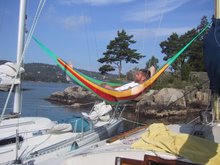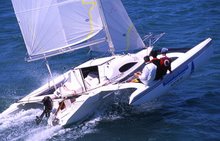This is what one rudder half looks like right out of the bag. This time I did both the skin with structural reinforcements and foam core in one go, leaving the centre core area untouched. The core was pre shaped to fit the skin, but left high. The HD inserts was left even higher as can be seen here.
Then, using a router in a home made jig, I cut everything back flush with the centreline. Then I digged out the foam to give room for the centre core. This also gave me an extra quality control opportunity, as the core to skin bond was inspected and tested all along the recess. It was of excellent quality.
Here, the two halves seen in the background as the core is being laminated with the last piece of carbon sleeve visible on the vacuum table. After this I applied thickened epoxy (cotton chop/micro fibres) to the recesses and wetted the foam surface of both halves before I placed the core in the recess and joined the two halves.
Holes are CNC'ed in each corner of the mould for alignment, and the halves were bolted together and then placed on the table in order to cure under vacuum.
You can see here the rudder moulds under vacuum. Bolts extending under the breather. Object is to compress the two halves together, and make sure the whole mould is as straight as my vacuum table. Please note the pencil added inside the bag, hopefully it will take notes from the process. On top mast plans and jib halyard block, the builder obviously already in another mood. The observant reader may have taken note of the wall now seemingly very close to the table; this is not the fact as it is the opposite: The table has been moved closer to the wall in order to accomodate carbon cutting in front of it.
The mast building is coming up. I decided it was enough of filling and sanding. The original finish of the moulds was obviously not perfect, and still it has proven to be a very effective piece of engineering, so I decided to move on. Grey is my added fairing compound, black is old gel coat, now wet sanded till my shoulders hurt. My fingers tell me it is ok.
This is a close up of an area
earlier published on this blog, now feeling quite fair.
I cut the foam for the lower aft half, which will be the first part to be infused. I'm using 8mm pre perforated Divinycell H100 foam core for better panel stiffness (buckling resistance) on the less curved parts of the mast. I will use this as a core for the central shear web as well.
The sail track insert is from electrician's PVC tube that come in maximum 4m length and has to be extended. I don't need much strength in the join, as that will come as a part of the lay up, but air tightness is absolutely necessary for the infusion process to work out.
Trial fitting the foam panels for the lower aft half. At this stage the foam was also cut to fit the molded in pre bend of the track. After this photo was taken, the foam was removed, and the mould is worked over with the mould sealer. Aluminum T-profiles that will be used for making glueing flanges and -recesses was also cleaned.
Five layer of wax is next. I'll have an idea how well this release system works tomorrow, when I remove the moulds from the rudder. That will hopefully be a bit of fun. I have to do the rudder finish and get on with the rudder case in order to be ready for last shaping of hull before filling and fairing starts early December, hopefully.

































